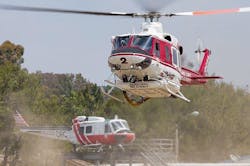Documents Say Fight over CA Helicopter Service Puts Victims at Risk
Source The Orange County Register
Bickering between sheriff’s deputies and firefighters over which agency should conduct air rescues in Orange County has led to delays in getting injured people to hospitals, raising concerns that the running feud could impair medical care and put taxpayers at risk of unexpected legal payouts.
In one 2016 incident, detailed in a letter by the county’s Emergency Medical Services director obtained by The Orange County Register, a conflict between sheriff’s deputies and Orange County Fire Authority paramedics delayed the transport of an elderly woman with a serious head injury. The woman required emergency neurosurgery at an area trauma center.
The patient suffered “subsequent disability,” according to the Jan. 10, 2017, letter to the Orange County Sheriff’s Dept. The medical director didn’t say whether the delayed transport contributed to that outcome.
“In this event as well as previously reviewed events, it appears that (the sheriff’s department’s) air rescue is delayed by (OCFA) ground units,” Dr. Sam Stratton, medical director of Orange County EMS authority, wrote in a report that fire officials described as one-sided.
“It is realized that there may have been harassment, interference with care of a critical victim, and failure to perform operational duties,” Stratton wrote.
In a separate 2016 letter, Sheriff’s Captain Joe Balicki offered more detail: a fire authority battalion chief, he wrote, “inserted himself directly over the patient and created a physical barrier” that prevented the sheriff’s medical flight crew from treating the woman and delayed her transport to the hospital for nearly five minutes.
Fire officials said they had not been interviewed in Stratton’s review.
“This appears to be a biased, rush to judgment with speculative, gratuitous, and improper statements,” said fire authority Battalion Chief Marc Stone.
During the past two years, the fire authority and the sheriff’s department have competed for control of air rescue operations in the county’s remote areas, leading to clashes in which both agencies have sent helicopters to the same scene, causing dangerous mid-air face-offs. The fights — which have included ignoring directives from air traffic personnel — have become so frequent and perilous that county supervisors decided Tuesday to refer the problem to the California Office of Emergency Services in an effort to negotiate a truce.
Sheriff Sandra Hutchens also recommended renewing mediation and sending the dispute to the Public Safety Aviation Accreditation Commission, a group that oversees voluntary standards for aviation.
County officials haven’t publicly discussed what the feud might mean to the safety of people injured in wilderness areas. But Stratton’s letter, along with complaints from the fire authority, reveals that public medical workers have documented concerns that the feud could – and has – endangered some patients.
The Nov. 6, 2016, incident described in the letter differed from many of the other clashes, which typically have involved helicopter pilots for both agencies. The episode described by Stratton involved sheriff’s helicopter personnel and fire authority ground crews, and an unnamed woman who was injured when she was struck by a mountain bike on Willow Canyon Trail in Laguna Beach.
The woman’s injury, in Laguna Coast Wilderness Park, demanded a “timely” air rescue, according to Stratton. He wrote that it was “unclear why both (Fire Authority) ground and (sheriff’s) air crews were dispatched to this event” because “from a medical perspective, it would seem appropriate to dispatch an air rescue unit only.”
A written statement from a sheriff’s paramedic on the scene, Deputy Andrew McMillan, described how the bickering amped up an already tense situation.
“The daughter was crying and hysterically yelled, ‘Can you guys stop arguing and help my mother?'”
McMillan also said the woman’s brain was bleeding at the time.
Sheriff’s Commander Stu Greenberg said his department asked the county’s Emergency Medical Services authority to review the incident in 2016.
“Her injuries were extensive and required the quickest response possible,” Greenberg said.
Stone said the sheriff’s department’s account was “nothing more than an allegation.”
Stratton did not return calls requesting comment.
Although it’s unclear if the patient’s injuries in the Willow Canyon rescue were made worse by the conflict, doctors say time is a critical factor in emergency rescues.
“Minutes can make a huge difference in whether someone lives or dies,” said Dr. Kenji Inaba, a trauma surgeon and associate professor of surgery at the University of Southern California.
Though Inaba did not comment specifically on the specific rescue, he said the most common cause of preventable death after injury is hemorrhaging, an injury that often can’t be treated in the field.
In other instances from the past year, fire authority personnel have alleged that it was sheriff’s responders who endangered patients.
In August, sheriff’s deputies attempted to “snatch” a surfer with a spinal cord injury from fire paramedics during a rescue at Cotton’s Beach in San Clemente, according to a fire authority complaint to the state Department of Forestry and Fire Protection.
The fire paramedic told four sheriff crew members that he had control of the rescue.
“As we were talking, the other (sheriff’s) crew members attempted to take control of the patient and almost ‘snatch and grab’ the patient from us,” the paramedic said. “I advised them to stop, not move the patient and the patient was still in my care.”
Deputies argued that their helicopter was present and ready to transport the patient, while the fire authority aircraft was still en route.
The patient was transferred by the incident commander to the care of sheriff’s deputies, who needed help from firefighters to load him into the sheriff’s helicopter.
Sheriff’s officials disputed the “snatch” allegation.
“Complaints regarding the actions of our air support unit on search and rescue calls are continually unfounded and misleading,” said sheriff’s spokesperson Carrie Braun.
In another incident, on Feb. 17, three sheriff helicopters and one fire helicopter fought over the rescue of a fallen mountain biker in Santiago Oaks Regional Park. The sparring caused several near-misses, according to a complaint to state fire officials filed by the Orange Fire Department.
“There is no way of knowing whether patient care was compromised,” said the complaint. “Operating four helicopters without proper coordination, common communications and an important understanding of operational capabilities was completely unsafe.”
The feud also could lead to something unexpected for taxpayers — lawsuit payouts.
Typically, government agencies are immune from most liability claims, including injuries sustained during rescues. But that immunity doesn’t extend to negligence, and some lawyers believe the documented delays in health treatment as a result of inter-agency bickering could cost public agencies and taxpayers in the event of litigation.
Stratton wrote that if there was a “physical interruption of patient care (in the Laguna Beach incident) that resulted in delay of the medical management of the victim, this likely will be a major factor in any potential civil lawsuits filed on behalf of the victim.”
Irvine attorney Edward Susolik agreed.
“One could reasonably conclude that delaying medical care to a seriously injured person to argue with another public agency is grossly negligent or even in bad faith,” said Susolik, a senior partner at the Irvine law firm Callahan & Blaine.
“It is common knowledge that some of the most critical treatment that patient receives occurs in the minutes after an accident or injury.”
It’s unclear how many times sheriff’s responders and fire pilots have come to rescue the same person, and it’s unknown how many of those incidents, if any, compromised a patients’ treatment. In 2017, sheriff’s air support unit conducted 58 rescues, according to the department. In 2016, the latest data available, the fire authority conducted 131 rescues. Both agencies spend about $4 million a year on helicopter rescue operations, and both agencies insist they wouldn’t have to cut those budgets, or personnel, if their rescue role is changed.
Both agencies also insist that they are better qualified than the other to make air rescues. Sheriff’s helicopters tend to arrive first to scenes, while fire helicopters tend to get people to hospitals faster.
In October, county supervisors voted to give the sheriff’s department control of search and rescue operations, ending an arrangement in which fire pilots had been the primary responders since at least the 1990s. But the sheriff’s department didn’t assert full control of those duties until Jan. 16 when Hutchens ended the agreement with the fire authority. The two parties have been in mediation for months and met at least 40 times to negotiate a solution to their conflict, but the talks have gone nowhere.
Fire authority leaders said they’ll ignore Hutchens’ recent decision and continue responding to helicopter rescue calls.
County Counsel Leon Page said Tuesday that the sheriff’s department could report close encounters with fire authority helicopters and paramedics to the district attorney for criminal prosecution. Page said prosecutors could file charges against OCFA pilots for “interfering” with a “peace officer in the performance of their duties” – a state crime.
———
©2018 The Orange County Register (Santa Ana, Calif.)
Visit The Orange County Register (Santa Ana, Calif.) at www.ocregister.com
Distributed by Tribune Content Agency, LLC.






